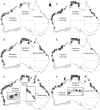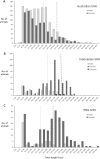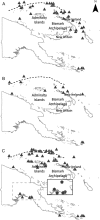Crossing lines: a multidisciplinary framework for assessing connectivity of hammerhead sharks across jurisdictional boundaries - PubMed (original) (raw)
Crossing lines: a multidisciplinary framework for assessing connectivity of hammerhead sharks across jurisdictional boundaries
A Chin et al. Sci Rep. 2017.
Abstract
Conservation and management of migratory species can be complex and challenging. International agreements such as the Convention on Migratory Species (CMS) provide policy frameworks, but assessments and management can be hampered by lack of data and tractable mechanisms to integrate disparate datasets. An assessment of scalloped (Sphyrna lewini) and great (Sphyrna mokarran) hammerhead population structure and connectivity across northern Australia, Indonesia and Papua New Guinea (PNG) was conducted to inform management responses to CMS and Convention on International Trade in Endangered Species listings of these species. An Integrated Assessment Framework (IAF) was devised to systematically incorporate data across jurisdictions and create a regional synopsis, and amalgamated a suite of data from the Australasian region. Scalloped hammerhead populations are segregated by sex and size, with Australian populations dominated by juveniles and small adult males, while Indonesian and PNG populations included large adult females. The IAF process introduced genetic and tagging data to produce conceptual models of stock structure and movement. Several hypotheses were produced to explain stock structure and movement patterns, but more data are needed to identify the most likely hypothesis. This study demonstrates a process for assessing migratory species connectivity and highlights priority areas for hammerhead management and research.
Conflict of interest statement
The authors declare no competing financial interests.
Figures
Figure 1. Locality map showing the scope of the asessment region across Australasia and Indonesia.
The map shows the countries and major regional features discussed during the assessment. Figure created using ArcGIS 10.2.1.
Figure 2
Indicative distribution of: (A–C) scalloped hammerhed (triangles) and (D–F) great hammerhed (circles) sharks for sex and size categories from sampled locations. (A,D) adult females, (B,E) adult males, (C,F) immature and neonate individuals of both sexes. Insets show indicative distribution of neonates. Grey shading denotes spatial grids where fishing and sampling effort occurred. Note: more detailed information on fishing effort is not available due to confidentiality provisions of data-sharing agreements and fisheries monitoring programs. Data for scalloped hammerheads from PNG presented in Fig. 4. Spatial information for Indonesia was not available. Figure created using ArcGIS 10.2.1.
Figure 3
Size frequency distributions of scalloped hammerheads recorded in fisheres catches in Australia (A), Indonesia (B) and Papua New Guinea (C) showing the low numbers of adult females in Australian waters but occurrence in Indonesia and Papua New Guinea. Dotted lines indicate size at maturity for males (light grey) and females (dark grey).
Figure 4. Distribution of scalloped hammerheds in Papua New Guinea.
(A) adult females, (B) adult males, (C) immature and neonate individuals of both sexes. Insets denote neonates (pentagons). Dashed line represents the edge of the continental shelf – North Bismark Plate. Figure created using ArcGIS 10.2.1.
Figure 5. Conceptual population structure model of scalloped hammerhead sharks in Australasia.
TS indicates the Torres Strait land bridge, GoC is the Gulf of Carpentaria, NT is the Northern Territory, Figure created using ArcGIS 10.2.1 and biogeographic features added using Adobe Photoshop CC2015.
Similar articles
- Genetic connectivity of the scalloped hammerhead shark Sphyrna lewini across Indonesia and the Western Indian Ocean.
Hadi S, Andayani N, Muttaqin E, Simeon BM, Ichsan M, Subhan B, Madduppa H. Hadi S, et al. PLoS One. 2020 Oct 1;15(10):e0230763. doi: 10.1371/journal.pone.0230763. eCollection 2020. PLoS One. 2020. PMID: 33002022 Free PMC article. - Identification of young-of-the-year great hammerhead shark Sphyrna mokarran in northern Florida and South Carolina.
Barker AM, Frazier BS, Bethea DM, Gold JR, Portnoy DS. Barker AM, et al. J Fish Biol. 2017 Aug;91(2):664-668. doi: 10.1111/jfb.13356. Epub 2017 Jun 27. J Fish Biol. 2017. PMID: 28653346 - Age, growth and maturity of the pelagic thresher Alopias pelagicus and the scalloped hammerhead Sphyrna lewini.
Drew M, White WT, Dharmadi, Harry AV, Huveneers C. Drew M, et al. J Fish Biol. 2015 Jan;86(1):333-54. doi: 10.1111/jfb.12586. J Fish Biol. 2015. PMID: 25557431 - Risk management frameworks for human health and environmental risks.
Jardine C, Hrudey S, Shortreed J, Craig L, Krewski D, Furgal C, McColl S. Jardine C, et al. J Toxicol Environ Health B Crit Rev. 2003 Nov-Dec;6(6):569-720. doi: 10.1080/10937400390208608. J Toxicol Environ Health B Crit Rev. 2003. PMID: 14698953 Review. - Larval dispersal and movement patterns of coral reef fishes, and implications for marine reserve network design.
Green AL, Maypa AP, Almany GR, Rhodes KL, Weeks R, Abesamis RA, Gleason MG, Mumby PJ, White AT. Green AL, et al. Biol Rev Camb Philos Soc. 2015 Nov;90(4):1215-47. doi: 10.1111/brv.12155. Epub 2014 Nov 25. Biol Rev Camb Philos Soc. 2015. PMID: 25423947 Review.
Cited by
- Fisheries-independent surveys identify critical habitats for young scalloped hammerhead sharks (Sphyrna lewini) in the Rewa Delta, Fiji.
Marie AD, Miller C, Cawich C, Piovano S, Rico C. Marie AD, et al. Sci Rep. 2017 Dec 8;7(1):17273. doi: 10.1038/s41598-017-17152-0. Sci Rep. 2017. PMID: 29222430 Free PMC article. - Reconciling differences in natural tags to infer demographic and genetic connectivity in marine fish populations.
Reis-Santos P, Tanner SE, Aboim MA, Vasconcelos RP, Laroche J, Charrier G, Pérez M, Presa P, Gillanders BM, Cabral HN. Reis-Santos P, et al. Sci Rep. 2018 Jul 9;8(1):10343. doi: 10.1038/s41598-018-28701-6. Sci Rep. 2018. PMID: 29985467 Free PMC article. - Decline of coastal apex shark populations over the past half century.
Roff G, Brown CJ, Priest MA, Mumby PJ. Roff G, et al. Commun Biol. 2018 Dec 13;1:223. doi: 10.1038/s42003-018-0233-1. eCollection 2018. Commun Biol. 2018. PMID: 30564744 Free PMC article. - Conceptual frameworks and key questions for assessing the contribution of marine protected areas to shark and ray conservation.
Chin A, Molloy FJ, Cameron D, Day JC, Cramp J, Gerhardt KL, Heupel MR, Read M, Simpfendorfer CA. Chin A, et al. Conserv Biol. 2023 Feb;37(1):e13917. doi: 10.1111/cobi.13917. Epub 2022 Dec 28. Conserv Biol. 2023. PMID: 35435294 Free PMC article.
References
- Costa D. P., Breed G. A. & Robinson P. W. New insights into pelagic migrations: implications for ecology and conservation. Annu. Rev. Ecol. Evol. Syst. 43, 73–96, doi: 10.1146/annurev-ecolsys-102710-145045 (2012). - DOI
- Bull J. W., Suttle K. B., Singh N. J. & Milner-Gulland E. J. Conservation when nothing stands still: moving targets and biodiversity offsets. Front. Ecol. Environ. 11, 203–210, doi: 10.1890/120020 (2013). - DOI
- Rooker J. R. et al.. Crossing the line: migratory and homing behaviors of Atlantic bluefin tuna. Mar. Ecol. Prog. Ser. 504, 265–276, doi: 10.3354/meps10781 (2014). - DOI
Publication types
LinkOut - more resources
Full Text Sources
Other Literature Sources




